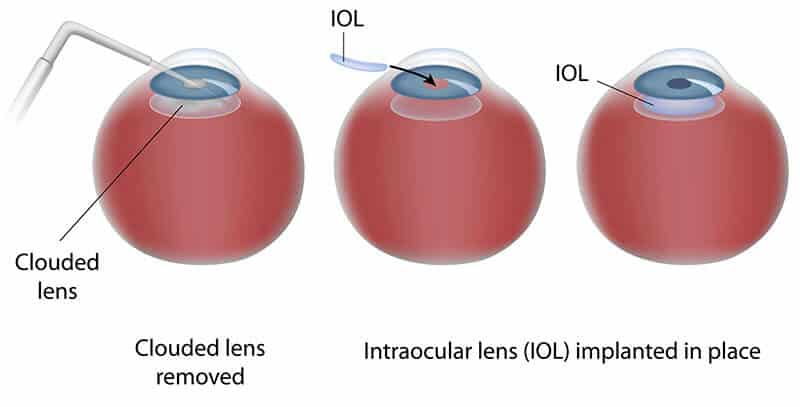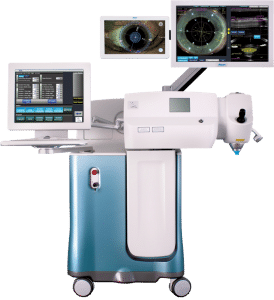
In a normal eye, the lens is clear. In an eye that has a cataract, the lens has become cloudy or tinted. It is like a window that has become fogged with steam. The development of a cataract is usually age related. However, there are other reasons cataracts develop. For instance, long term medication use, medical problems such as diabetes, an injury to the eye, or long term unprotected exposure to the sun. These can all preclude cataract development.
Please click on Before, After and Lifestyle options to see what your site looks like for each of the above options.
It is not possible to give an answer to how fast a cataract develops. This depends on the individual and circumstances. When a cataract develops due to age, it may happen gradually over years. People with diabetes or taking medication might develop a cataract over a period of months. If the clouding of the lens is away from the center, a person might not even know they are developing a cataract.
Often a patient ends up at an ophthalmologist’s office because they are experiencing some or all of the above symptoms. Upon receiving a thorough eye examination, the presence and extent of the cataract can be determined.
Having a cataract is a treatable condition. If a cataract is mild, a change in your eyeglass prescription might be all that is needed to improve your vision. However, surgery is THE ONLY WAY to remove a cataract. Medications, vitamins, exercises and or optical devices will not prevent or cure cataracts. Cataract surgery should be considered when the decreased vision interferes with your daily activities.
Cataract surgery is performed by an ophthalmologist as an outpatient service either at a hospital or an ambulatory surgery center. The operation is typically done under a local anesthetic. During cataract surgery the cloudy lens is removed from the eye and usually replaced by a permanent intraocular lens implant. Incredible advances have been made in the technology and procedures used by an ophthalmologist to perform this surgery. Westford, MA Eye Surgeon, Dr. Baharozian performs “NO STITCH” cataract surgery. As the name implies, the incision used to remove the cloudy lens and replace it with an implant is small enough that stitches are not necessary. This is a large benefit because it reduces the chance of complications and improves healing time.

Dr. Baharozian performs cataract surgery on an outpatient basis at Surgisite North in Chelmsford.
The operation is typically done under a local anesthetic. You will also be given medication to relax you. During cataract surgery the cloudy lens is removed from the eye and replaced by a permanent intraocular lens implant. Incredible advances have been made in the technology and procedures used to perform this surgery.
Dr. Baharozian performs “NO STITCH” cataract surgery which is beneficial because it reduces the chance of complications and improves healing time. Each year more than 1.4 million people undergo cataract surgery. Over 90% have improved vision and more than 95% of the patients experience no complications.
The overall health of your eye, your eyeglass prescription and your lifestyle are factors to consider when choosing which lens implant is right for you.


A standard Monofocal Lens implant offers sharply focused vision at one distance.
A premium Toric Monofocal Lens implant offers sharply focused vision at one distance and reduces your astigmatism. This allows for less dependence on glasses after surgery.
A premium Multifocal Lens implant can provide improved vision at near, intermediate and distance with less dependence on glasses.
The overall health of your eye, your eyeglass prescription, your lifestyle and visual expectations after surgery are all determining factors to consider when choosing which lens implant is right for you.


Every year, millions of Americans have cataract surgery. The goal of the surgery is to remove a cloudy natural lens and replace it with an intraocular lens (IOL) to improve vision. During cataract surgery, the cloudy lens is broken into tiny pieces and then the surgeon removes the pieces. Traditionally, a surgeon would use metal knives and blades in order to manually make the incisions needed for this process. Now, however, Dr. Baharozian can offer you a ‘bladeless’ procedure, which is assisted by laser technology.
Laser-assisted cataract surgery offers customization to each patient with predictable and enhanced precision. The traditional ‘manual’ part of the procedure is now preformed by a laser. The technology behind the laser captures high-resolution images of your eye, giving precise measurements and data that assist Dr. Baharozian in planning and performing a procedure to exacting specifications.

Monofocal implants provide a single focus when you are not wearing glasses. Depending upon the lens power selected by the eye surgeon, the eye may see best at either far, near or intermediate (midrange) distance when eyeglasses are not worn. Most people who have cataract surgery with a monofocal IOL choose to have a lens that provides good distance vision without eyeglasses.
With a monofocal IOL set for distance, you will need to wear reading glasses for close-up vision. Conversely, if you choose to have a monofocal IOL set for near vision, allowing you to read without eyeglasses, then you will need eyeglasses to see clearly in the distance. With a monofocal lens and the appropriate bifocal (or trifocal) eyeglasses, you can expect to see well at all distances. Dr. Baharozian primarily implants the Clareon® and Tecnis® monofocal lenses.


A specialty variation of the monofocal lens, called a toric lens, has recently been developed for patients with moderate to high astigmatism (a football shaped cornea). While mild astigmatism can be treated at the time of surgery by making extra tiny incisions in the peripheral cornea called limbal relaxing incisions (LRI), larger amounts of astigmatism are better treated with toric lens to provide clear vision at a single distance without glasses. Astigmatism can also be addressed with laser vision correction (PRK or LASIK). Dr. Baharozian implants the Clareon® Toric lens.
Multifocal lens implants were developed to make patients less dependent on eyeglasses for both near and distance vision after cataract surgery. Multifocal lenses use specially designed focal zones on the surface of the lens. Light rays are focused through the different zones to provide sharply-focused images at both near and distance. The ability to read without eyeglasses and the reading distance can vary because of individual factors, but is generally best when the multifocal lens implant is placed in both eyes. Haloes may be present following implantation of a multifocal lens but these usually fade as the brain adapts to this new lens. Also, a laser vision correction procedure (PRK) may be needed after implantation of a multifocal lens should a significant refractive error (such as astigmatism) be present after cataract surgery. Dr. Baharozian and his medical staff will determine if each patient is a candidate for a multifocal lens. Dr. Baharozian implants the Clareon Vivity® and Clareon PanOptix® Multifocal lens.
An additional strategy to give clear vision both at near and far without glasses is called monovision. This technique uses traditional monofocal IOLs to allow for near or intermediate vision in one eye and distance vision in the other eye. Not everyone is comfortable with this difference in focus, but many people find they adapt well to monovision when they try it out first using contact lenses before having cataract surgery.
Are you searching for a cataract surgeon in the greater Westford, MA area? Contact Dr. Baharozian and the team at Family Eye Care Center & Optical Gallery.
Request an Appointment